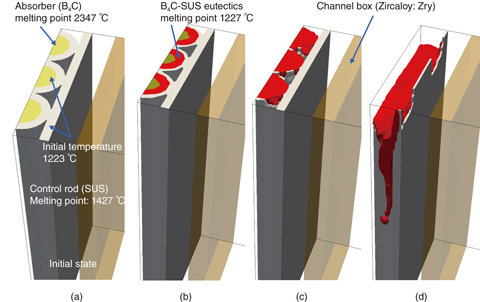
Fig.1-12 Growth of the liquid phase (red region) induced at the interface between B4C inside the control rods (yellow region) and SUS, as well as its melt-relocation behavior
In the accident at the TEPCO’s Fukushima Daiichi NPS, the meltdown is believed to have occurred in the reactor pressure vessel (RPV), after which molten fuel reached the lower head. Although it is very important to understand the distribution of molten fuels distribute in the RPV in detail, this is quite difficult to measure because of high radiation levels. In this case, a numerical simulation is useful. However, existing severe-accident-simulation methods that treat meltdowns have been insufficiently validated in terms of their assumptions and numerical models. Therefore, we face the problem that information concerning the relocation paths and circumstances of the debris distribution in the RPV’s lower head cannot be obtained with sufficient accuracy. Thus, to elucidate melt behavior in severe accidents, we have been developing a new simulation method, according to which the core-meltdown process and its pathway can be evaluated using supercomputers by eliminating assumptions and simplifying models.
In the reactor core during severe accidents, chemical reactions occur at the interface between the control rods (stainless steel or SUS) and the absorber (boron carbide or B4C). From previous experiments, it is known that at temperatures beyond a certain threshold, materials melt. Because this threshold is much lower than the melting points of SUS and B4C, our method must consider the growth of the liquid phase and its downward-relocation behavior. Since a method that accounts for the complicated liquid-phase formation has yet to be established, we develop a new liquid-phase-growth model that is suitable our numerical method.
As shown in Fig.1-12, we confirmed that the method could treat the following phenomena: 1. Liquid-phase formation at the interface between the control rod and the absorber; 2. Growth of the liquid phase; 3. Downward relocation of the liquid phase. Therefore, it is possible to calculate the melt-relocation behavior that may occur in actual accidents.
Toward the elucidation of the molten-fuel distribution in the RPV or PCV, we will check the validity of the model through comparison with experimental results and implement oxidation and radiation models. We will perform a more accurate simulation of core-melt-relocation behaviors in the near future.